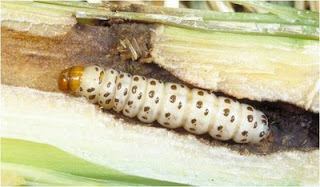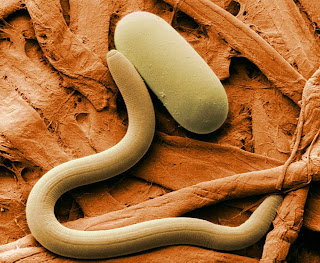
Ric Bessin, Extension Entomology, University of Kentucky
So you have a Bt corn hybrid and the seed is treated with a systemic insecticide, do you need to worry about insect pests? Well, the answer is … probably not, but there are some pests and / or situations that can cause some problems. Getting a uniform plant stand with uniform vigor is one of the first steps to reaching the yield potential of a hybrid this year. In this article I’ll discuss a few unusual situations where our preventive controls may not always provide the level of control that is needed.
Early in the season we worry about uniform stand establishment and use seed treatments to protect against seedling losses to seedcorn maggot, white grubs, wireworms, and cutworms. The seed treatments do a fine job to protect seeds and seedlings in nearly all fields, but excessive pest levels, cold soils and slow germination, and some hybrids with weak vigor can contribute to increases losses to seedling pests. These problems are often associated with a history of problems in the same field in the previous year or two. As an example, we have seen serious stand losses to wireworms that required replanting when treated seed was used, but the field had a history of serious wireworm losses, was planted very early into cold soils (it took 21 days to spike through), and was a hybrid with low to moderate seedling vigor. Replanting with the same treated hybrid seed into warmer soils enabled rapid germination and growth provided an excellent stand. Seed treatments with higher levels of the insecticide active ingredient will provide higher levels of protection, and protection for longer periods of time, than that provided by the low rates.
This year we are likely to have fewer fields planted very early due to the prolonged wet cool weather across much of the commonwealth, with a few growers feeling that there are getting corn planted later than usual. This is likely to potentials reduce risk with wireworms. While planting corn in mid to late April doesn’t increase risk to corn borers, plantings in May are at greater risk to both European and southwestern corn borers late in the season (second and third generations).

Growers using Bt corn for corn borer control or stalk corn borer/rootworm hybrids should consider using these with their later plantings. Growers not using Bt hybrids will need to scout their fields to monitor for corn borer larvae feeding in whorls, leaf axils, and leaf midribs beginning mid July. Foliar treatments for corn borers are only effective when applied before the larvae begin to tunnel into the stalk. Generally, the larvae will begin stalk tunneling when they reach the 4th instar stage.
Bt Techologies for Corn Insect ManagementThere is now a wide variety of Bt technologies to manage many of our more difficult to control corn insect pests. These different technologies may use different proteins developed from gene belonging to various Bacillus thuringiensis strains. There are many differences between these different technologies that are sold under different trade names. Generally, in Kentucky, these products provide very good control of the insect pests that they indicate they will control. They perform as advertised in our state. However, with the Bt technologies for Lepidoptera (corn borer and its allies) control, there are significant differences in the spectrum of pests that are listed for the different technologies. While they all target and provide very good control of both corn borer species, some will also control additional Lepidopteran pests which are more common in the southern cornbelt including corn earworm, black cutworm, fall armyworm, true armyworm, and lesser corn stalk borer. The list below includes the technologies currently available:
| Corn Borer BT | Rootworm BT | CB+RW BT (Stalked) |
|---|
| YieldGard CB | YieldGard RW | YieldGard Plus |
| Herculex 1 | Herculex RW | Herculex Xtra |
| Agrisure CB | Agrisure RW | Agrisure CB/RW |
| YieldGard VT Pro | YieldGard VT RW | YieldGard VT3
YieldGard VT3 Pro |
Syngenta recently had a new Bt technology approved by the EPA (although USDA approval is still pending) for its VIP3A (vegetative insecticide protein for Bacillus thuringiensis). This will target several Lepidopteran insect pests of corn.



